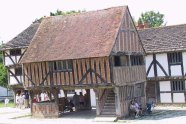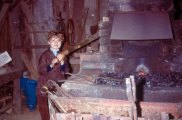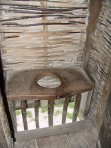Tuesday, 28 June 2005
A 'Perfect' Day
Topic: Miscellanea
I have just discovered that the 28th June or June 28th, as is preferred on the other side of the Atlantic, is the
only date with perfect numbers,
6 and
28. What is a perfect number? Well, it is an interger which is the sum of its proper positive divisors. [That sounds very erudite, but I
copied it!]
Six is the first perfect number because it can be divided by 1, 2 and 3. Add them up and 1+2+3=6. Twenty-eight happens to be the next perfect number because it can be divided by 1, 2, 4, 7 and 14. Just as before, 1+2+4+7+14=28. After 6 and 28 comes a perfect 496, 8128, 33550336 and 8589869056. I wonder if anyone noticed on June 28th in the year 496? So the next extra special June 28th will be in the year 8128. Too bad I won't be here to celebrate it!
If you are interested in the mysteries of Egyptian Fractions, or you want to know how to drive your maths teacher nuts, visit
Dr. Stuart Savory's Blog.
Monday, 27 June 2005
Amazing Animals: The Emperor Penguin
(No. 3 in my series)
Topic: Nature and Our World

I've always been fascinated by that most marine of birds, the
penguins, an ancient branch of the animal kingdom. Ancestral penguins were well established some 50 million years ago, which probably makes them one of the oldest of the class of Aves (birds). All penguins belong to the order Sphenisciformes, a term which refers to their narrow, flipper-like wings. The word comes from the Greek,
spheniskos, meaning 'a small wedge'. Unlike other birds, penguins can't fold their 'wings' because their elbow joint is fixed. The flipper only moves at the shoulder joint - an adaptation which gives them more power when 'flying' through the water. They are also unique amongst birds because, apart from a brief appearance of wing quills early in the embryonic stage, they do not have any flight feathers on their wings. Their large, webbed feet and their tails are used as rudders enabling them to 'dart' about with amazing agility when chasing fish or shrimps. Their unusual beak structure, formed of several layers of horny plates, indicates a distant relationship to the albatross. However, without doubt, they are the champion swimmers and divers amongst all sea birds.
On land (or ice), penguins are rather comical creatures because they are handicapped by their extremely short legs, which are set far back on their chunky streamlined bodies. They are forced to stand upright and hop or waddle along. This make them appear 'human-like' and they have been compared to nuns dressed in a black and white habit or to men in evening dress! Actually, penguins can move very fast on icy ground by falling down and tobogganing along using their feet. It is said that they can go faster this way than a man on skis.
Scientists have recognised at least 32 species of extinct penguins, some of them quite large.
Anthropornis of the South Orkneys and
Palaeudyptes of New Zealand stood more than five feet tall. Today, there are about 17 species of penguin alive although some scientists classify the white-flippered variety of fairy penguin,
Eudyptula albosignata, as an 18th variety. Of these, the most amazing species for me is the
Emperor Penguin,
Aptenodytes forsteri. It is the largest and tallest of the penguins with males reaching some 4 feet in height. Did you know that Emperor penguins are capable of swimming underwater at up to 37 miles per hour propelled by their strong flippers - a speed which rivals that of seals and porpoises? They can also dive up to 870 feet and remain submerged for up to 18 minutes.
For their first three or four years until they reach maturity, the Emperor penguins spend their time feeding in the krill-rich waters off the coast of Antarctica. Their preferred food is fish and squid. Emperor penguin's breed every year and their breeding cycle begins in March, autumn in the southern hemisphere. It is one of the few birds not to start its reproductive cycle in the spring but there is a good reason for this apparent madness, as we shall see. The adult penguins congregate on the ice returning unerringly to the same spot where they bred the previous year. Here they go through their courtship and in May, just as the sun is setting for the long antarctic winter, the female lays her single egg. This is immediately passed over to the male bird and the egg is held carefully on his feet tucked under a warm fold of abdominal skin. The females then disappear returning to the sea to feed leaving the males to incubate the precious egg, a process which takes 62 to 64 days.

During this period, the males huddle together for warmth and for protection from the howling winds (which can reach 100 mph in a storm). Emperor penguins are specially adapted to survive these harsh conditions as their body size and shape gives them a lower 'surface-to-volume' ratio and their flippers are much smaller proportionally than any other penguin. All penguins have developed a heat-exchange system of blood vessels in their flippers and legs so that returning venous blood is warmed up by the outgoing arterial blood. Emperors also have an exceptional heat-exchange system in their nasal passages, which recovers much of the heat added to the cold air they breathe in. They also have long, double-layered, high-density feathers, which cover their legs.
Crowding closely together saves heat loss and each penguin shuffles along slowly gradually moving from the cold outer edges of the group to the warmer centre. During this time, the average temperature is around minus 4 degrees Fahreinheit (-20 degrees centigrade) but can drop to minus 40 degrees (-40C) or more and, if Papa Penguin drops the egg onto the ice or exposes it for just a few seconds, the embryo will die. At last the egg hatches and the starving parent, who will have lost about a third of his weight, still manages to feed his chick for a couple of days from a residue in his crop - all the while keeping the tiny downy chick tucked under his 'pouch' to keep warm. Timing it perfectly, Mama Penguin returns at this point and takes over the chick's care so that the male penguin can return to the feeding grounds. His fast will have lasted some 110-115 days. It is a long journey to and fro over the ice which is where the penguins' tobogganing trick comes in very handy.
Having put back his lost weight, the male returns by the end of August and both parents then take turns to feed the chick for the next three months. Because of the distance the parents have to travel over the ice, this is usually one very large meal every three to four days. However, as conditions improve, the sea ice gradually melts away, so the previously long journey to the breeding ground becomes much shorter and quicker.
By late spring, the chicks have fledged but they are still only 60% of the adult's weight, the lowest of any penguin. In early December, the young Emperor Penguin is finally at the stage when he can fend for himself. This is the most favourable time of the antarctic year, when the shore ice is melting and the antarctic summer is just beginning giving this amazing bird the best start in a life which can be as long as twenty years.
Friday, 24 June 2005
Crowned on this Day in 1509
Now Playing: I'm Henery the Eighth, I am
Topic: History

I always used to think of
Henry VIII, who was born on the 28th June 1491, as a particularly unpleasant monarch: a womanising, selfish, over-eating and cruel man. It seemed that he was responsible for so much evil during his reign. He turned against the Pope in 1532 and proclaimed himself Head of the Church of England so that he could 'divorce' his wife,
Catherine of Aragon (the marriage was actually annulled) and remarry. He dissolved the Roman Catholic monasteries, stole their chattels and their lands, vandalised and destroyed churches. During his reign, about 150,000 of his subjects were executed including his second wife,
Ann Boleyn, and his fourth wife,
Catherine Howard, who were both beheaded. Each of these unfortunate ladies had their marriages to the king annulled prior to their executions.
However, he is widely believed to be the composer of that lovely tune, "
Greensleeves" and, without doubt, he was an accomplished musician. He was highly educated and could converse in Latin, French and Spanish. He owned a large library of books, many with notes written in the margins in his hand. He was himself an author, publishing the
Assertio Septem Sacramentorum in 1521, and he wrote poetry. He was very tall for Tudor times (six feet two) and, in his youth, excelled at sports such as
Hare Coursing and
Royal Tennis.
So, what went wrong to turn him into such a tyrant in his later years? A sad, bloated old man, weighing around 28 stone, who trusted no one fully with the possible exception of his
court jester, Will Somers.
The young
Henry Tudor never expected to be King of England. He was the second son of
Henry VII and as such probably destined for the church. However, his brother, Arthur, Prince of Wales and heir apparent died at fifteen shortly after his marriage to Catherine of Aragon. At the time, Henry's father was very keen to secure an alliance with Spain and he was probably responsible for 'encouraging' the young Henry to seek a dispensation from the Pope to marry his brother's widow. Within fourteen months, the two were betrothed. However, by 1505, Henry VII had lost interest in an alliance with Spain and the young Henry was forced to declare that the engagement had been arranged without his agreement. Nevertheless, when Henry VII died, the King of Spain insisted on the marriage taking place and Henry married Catherine on 11th June 1509. They were both crowned at Westminster Abbey on 24th June 1509.
Did you know that they had a son, Henry, Duke of Cornwall? He was born on 1st January 1511 and died on 22nd February 1511. In fact, Catherine had six or seven pregnancies in all but only one child survived infancy, her daughter, Mary. It was when it was apparent that Catherine was too old to have any more children that Henry, who up to then had fathered at least six illegitimate children, decided he needed a male heir and resolved to marry again. History would have been so different if the baby Duke of Cornwall had lived!
I used to believe that Henry died of syphilis although there was no evidence of this disease in any of his children. Then I read an extremely interesting article in the April 2005 issue of the
BBC History Magazine which reported that new research suggests that Henry may have suffered from an endocrine abnormality called
Cushing's Syndrome. The symptoms are:
obesity, a 'buffalo' hump on the back, a swollen face with fat deposits beneath the eyes, irritability, depression, mood swings, paranoia, headaches, fatigue, aggression, impotence. This disease would have turned him into a psychotic paranoid with an erratic temper and could explain why he so often turned against those closest to him. He died on 28th January 1547, a feared and despised old man - a sad and ignominious end for one of Britain's most famous kings.
Thursday, 23 June 2005
A Sweet for a Special Occasion
Topic: Recipes and Food
This recipe was given to me by a professional cook in a local restaurant where I worked for a while when we first moved to Chichester. I can guarantee that it is absolutely delicious. However, I must confess that I have never made it myself. The reason is that I am completely at sea with USA measurements and I have never had the courage to experiment! At home, I
always use scales to weigh all cooking ingredients - preferably in ounces, although I am getting used to metric - that way I
know that what I am making will always turn out the same. I believe an American Cup is equivalent to 8 liquid ounces. Fine, but not all ingredients have the same volume. How much is a tablespoon or a teaspoon? A quick search on the
Internet gave me some U.S. volume equivalents but I am still confused! Perhaps you will be more at ease with the measurements than I am.
Strawberry DelightIngredients4 tablespoons butter
1½ cups very fine sugar
4 eggs, separated
½ teaspoon vanilla
1 cup flour
1 teaspoon baking powder
5 tablespoons light cream or milk
1/8 teaspoon salt (pinch of salt!)
2 tablespoons flaked unblanched almonds (flake from flat side with peeler or knife)
1 quart strawberries (plus sugar to sweeten)
1½ cups heavy cream, whipped, sweetened to taste
MethodPreheat oven to 350° F.
Cream butter and ½ cup of sugar until very light and fluffy. Beat in the egg yolks very well, one at a time. Beat in the vanilla.
Sift flour together with the baking powder. Add half to creamed mixture along with the milk or cream, fold in gently. Fold in remaining flour mixture. Divide into two well-greased layer pans and spread into an even layer.
Beat the egg whites together with the salt until stiff but not dry. Beat in remaining sugar, a tablespoon at a time, until the meringue is dull and very stiff and no longer feels grainy when rubbed between the fingers.
Divide the meringue between the two pans and spread over the cake mixture carefully with a spatula. Leave the surface rough. Sprinkle the almonds over the meringue in only one of the pans.
Bake about 45 minutes or until the meringue is lightly browned, puffed and crisp. Cool on a rack.
Slice the strawberries, reserving eight whole for decorating, and sprinkle with sugar to taste. Let stand for 15 to 20 minutes.
Fold sweetened sliced strawberries into the whipped cream and use as a filling between the cake layers. The almond layer should be on top.
Refrigerate 2 to 3 hours before serving. Decorated with reserved whole strawberries.
[Makes 10-12 servings]
Wednesday, 22 June 2005
King Solomon's Mines
Topic: Films and TV
Today is the anniversary of the birth of the British author,
Sir Henry Rider Haggard, who was born in
Bradenham, Norfolk, on 22nd June 1856. He wrote a number of first-class adventure novels but his most famous book is probably "
King Solomon's Mines", first published in 1885. It was an instant best-seller. H. Rider Haggard lived for some years in Natal, Africa, and is said to have had an affair with an African woman. Certainly, his sympathy for the native population comes through very strongly in his books.
Of course, it wasn't long before the film industry showed an interest in his stories and "King Solomon's Mines" was turned into a film. Actually, at least three films and a TV mini series have been made based on Rider Haggard's famous book. The first film, made in 1937 and largely forgotten, starred
Paul Robeson and
Sir Cedric Hardwick. The most recent version, made in 1985, starred
Richard Chamberlain and
Sharon Stone. However, the one I saw (and probably the best out of the three) was the
1950 version starring
Stewart Grainger and
Deborah Kerr.
I must have been 8-years-old when I was taken to see the film in London. The film tells the story of an adventurer who helps a woman look for her lost husband in Africa. I know I was totally enthralled with the African wildlife and the marvellous scenery. I believe two elephants were actually filmed being shot but I don't remember the carnage! I do remember that I particularly liked Umbopa, the tall black Prince with a snake carved into his stomach. I was very impressed also with the
Watutsi, that African tribe of very tall people, and their marvellous dancing and singing. (The Watutsi are also known as the
Tutsi, many of whom were slaughtered in their thousands by the Hutu in 1993.)
The film won well deserved Academy Awards for Best Cinematography, Color and Best Film Editing and was also nominated for Best Picture.
Monday, 20 June 2005
Father's Day
Topic: Family Days Out
My, it was hot yesterday and it's not much better today - can't cool down! We had a lovely day yesterday as all the family met at the
Open Air Museum at Singleton, not far from Chichester. Three proud Dads all celebrating Father's Day with the children and grandchildren. Thank goodness for a couple of big shady trees to sit under and enjoy the lovely picnic lunch my daughter brought.

The Museum is a collection of very old historic buildings which were rescued from demolition, carefully moved from their original sites and reconstructed in the West Sussex countryside for posterity to enjoy. One thing I noticed is how cool all these medieval buildings are inside - wish our house was as cool on a hot summer's day! Yesterday was a 'Father's Day' theme and there were all sorts of craft demonstrations to try your hand at. It was too hot to have a go at the
Pit Sawing but my son-in-law, Adrian, tried his hand at
Pole Lathe Turning. He got the foot treadle movement just right and was told that he was a natural "
Bodger"!
I felt sorry for the Blacksmith

demonstrating his trade in the Smithy. Warm work at the best of times let alone on such a hot day. To make matters worse, the Blacksmith was wearing a thick leather apron and what looked like flying boots to protect him from the sparks! I reminded my son about a previous visit many years ago when he was about 7-years-old. David had been completely fascinated by the Blacksmith then and I couldn't get him away from the Forge - he spent over an hour working the bellows. The Blacksmith was making a replica axe head, heating it in the fire and beating it with a hammer. When he finished it, he presented it to David as a reward for all his hard work. That wouldn't happen today as there is a cordon preventing the public from getting too close.
My daughter had a whale

of a time trying her hand at driving a tractor whilst all the grandchildren had rides on a buggy pulled by a couple of giant cart-horses and on a tractor trailer with hay bale seats which took them round the field. We sat under the trees sipping water and watching. We weren't able to visit all the buildings as the site is very large and it was too hot to gallop round. But, I just had to have another look inside my favourite building, the Bayleaf Farmhouse. This is quite a large timber framed hall house, originally from Kent, dating from the late 15th or early 16th century. The feature I like best is the 'toilet' in the upstairs bedroom which consists of a projection overhanging the back garden with a seat with a round hole over a disposal pit. Bit drafty but it was the height of luxury in the early 16th century!
We ended our day at the Royal Oak public house near Midhurst. We had marvellous food but the helpings were
really huge, no room for a pudding or even an ice cream!
Saturday, 18 June 2005
Tiger, Tiger....
Mood:
 caffeinated
Topic: Poetry and Poets
caffeinated
Topic: Poetry and Poets
I met a llama called Miguel on
BlogPartyWeekend.com, one of
Michael's sites. Just had to get my own pet - isn't she cute! Her name means 'Night'. Listen carefully - she growls sometimes! We both like the poem written by William Blake about the fearsome tiger.
|
|
The Tiger |
TIGER, tiger, burning bright
In the forests of the night,
What immortal hand or eye
Could frame thy fearful symmetry?
In what distant deeps or skies
Burnt the fire of thine eyes?
On what wings dare he aspire?
What the hand dare seize the fire?
And what shoulder and what art
Could twist the sinews of thy heart?
And when thy heart began to beat,
What dread hand and what dread feet?
What the hammer? what the chain?
In what furnace was thy brain?
What the anvil? What dread grasp
Dare its deadly terrors clasp?
When the stars threw down their spears,
And water'd heaven with their tears,
Did He smile His work to see?
Did He who made the lamb make thee?
Tiger, tiger, burning bright
In the forests of the night,
What immortal hand or eye
Dare frame thy fearful symmetry?
|
William Blake (1757-1827) |
|
Updated: 18 June 2005 14:33 BST
Friday, 17 June 2005
Microcalcification
Topic: Health Issues
Just over four weeks ago, I had to attend the mobile unit in the Festival Theatre Car Park in Chichester for a routine breast screening X-ray or
mammogram. They look after you very well in West Sussex and call all women between the ages of 50 and 64 for screening every three years, a scheme which they are gradually changing to include women up to 70 years of age.
Then, last week the letter arrives, "Please would you attend Worthing Hospital Assessment Centre for further tests". So, off I went last Wednesday. It was the left side they were interested in - more squashing between glass plates from various angles! Then the radiographer had to change all the plates to take yet another X-ray with a magnified film of the area. "That's it, you can get dressed and we will call you in a few minutes to see the Doctor".
Five minutes later, I am shown into the Consultant's room. All my X-rays are on a light board. He points at a tiny cluster of white dots; "These are tiny particles of calcium which we call Microcalcification", he said. He explained that these minute calcium deposits were, in all probability, harmless but, that they
could represent a pre-cancerous condition known as Ductal Carcinoma in Situ (DCIS). Despite the carcinoma tag, DCIS is non cancerous and cannot spread. However, if it is left, there is a chance that it could develop into a proper cancer eventually.
To determine whether DCIS is present, a sample is needed. That means, a stereo tactic core biopsy through a hollow needle. Sounds horrible but they give you a local anaesthetic and I was assured it would not be painful. "Are you needle phobic?" Well, I don't think so, after all I have donated blood over sixty times!
My appointment is on the 5th July and then I will have to return again to hear the result and find out if the microcalcification is benign, a very common condition requiring no treatment, or if they want to remove a chunk out of me! Will let you know how I get on.
Wednesday, 15 June 2005
Cockroaches and Human Fertility
Topic: In the News
So, it appears that the lowly cockroach, that detested insect pest, shares more with us ladies than just our kitchens. Biologists at Manchester University, who are undertaking research into increased fertility problems in women who put off having children until they are older, now believe that cockroaches hold the key to
the mysteries of women's fertility.
They are particularly interested in the mating behaviour of the dusky roach (Nauphoet cinera). The female cockroach is unusual as she bears live young and also experiences reproductive cycles and becomes less fertile with age. If breeding is delayed, the cockroaches lose reproductive potential apparently due to a
biochemical reaction which may be similar to that of human beings. Now, I ask myself, why do scientists spend so much time and so many resources on human fertility when half of the world population is starving?
If we believe what we are told, it is possible that in another fifty to sixty years scientists will have conquered
ageing, that inevitable process which causes the human cell to divide and reproduce a finite number of times with increasing errors. If that happens, my great, great grandchildren may be able to look forward to living to be 150 years old but - in what sort of world?
We have problems today with a growing percentage of pensioners compared to the working population. So, shouldn't a curb be put on human reproduction instead of trying to prolong human fertility? Do we really want to see women of sixty or seventy still bearing children? Do we really want to have to carry on working until we are ninety? Is the ultimate fate of mankind to live packed like sardines in mile-high tenements? In such a world, I envisage most people having to work from home because public transport and road systems can no longer cope. A nightmarish future where there are so many people that 'shifts' have to be imposed for recreational purposes or for shopping.
Learning all we can about the human genome is a good thing. But I wonder if scientists are considering all the consequences for humanity when they dream about prolonging human fertility.
Monday, 13 June 2005
World's Best Character Actor
Topic: In the News

Do you think that this man could be mistaken for 15 year old boy? Well, he was and more than once it seems! He is Frederic Bourdin, a Frenchman nicknamed the '
Chameleon'. He is a balding 31-year-old but he still managed to fool French social workers and fellow pupils at a school in Pau into believing that he was a teenage orphan. Can you believe that he actually spent a month in a children's home and at the school without raising suspicion! He was only found out because a teacher happened to watch a television documentary about his previous exploits and recognised him.
Apparently, "
he dyed his greying hair blond, meticulously shaved his beard, applied facial hair remover and covered his bald patch with a baseball cap to achieve the desired effect". [see
Telegraph]. He changed his voice and also fooled all his classmates with his perfect mastery of teenage gestures and slang! How on earth can somebody live a deception like that for several weeks without making a mistake!
He is obviously a born actor and, under different circumstances, would probably have been nominated for an Oscar for his performances. Instead, the disturbed imposter turned his talent to criminal impersonations of at least 36 imaginary teenagers plus taking on the identities of three missing boys!
Newer | Latest | Older





 I've always been fascinated by that most marine of birds, the
I've always been fascinated by that most marine of birds, the  During this period, the males huddle together for warmth and for protection from the howling winds (which can reach 100 mph in a storm). Emperor penguins are specially adapted to survive these harsh conditions as their body size and shape gives them a lower 'surface-to-volume' ratio and their flippers are much smaller proportionally than any other penguin. All penguins have developed a heat-exchange system of blood vessels in their flippers and legs so that returning venous blood is warmed up by the outgoing arterial blood. Emperors also have an exceptional heat-exchange system in their nasal passages, which recovers much of the heat added to the cold air they breathe in. They also have long, double-layered, high-density feathers, which cover their legs.
During this period, the males huddle together for warmth and for protection from the howling winds (which can reach 100 mph in a storm). Emperor penguins are specially adapted to survive these harsh conditions as their body size and shape gives them a lower 'surface-to-volume' ratio and their flippers are much smaller proportionally than any other penguin. All penguins have developed a heat-exchange system of blood vessels in their flippers and legs so that returning venous blood is warmed up by the outgoing arterial blood. Emperors also have an exceptional heat-exchange system in their nasal passages, which recovers much of the heat added to the cold air they breathe in. They also have long, double-layered, high-density feathers, which cover their legs.  I always used to think of
I always used to think of  The Museum is a collection of very old historic buildings which were rescued from demolition, carefully moved from their original sites and reconstructed in the West Sussex countryside for posterity to enjoy. One thing I noticed is how cool all these medieval buildings are inside - wish our house was as cool on a hot summer's day! Yesterday was a 'Father's Day' theme and there were all sorts of craft demonstrations to try your hand at. It was too hot to have a go at the Pit Sawing but my son-in-law, Adrian, tried his hand at Pole Lathe Turning. He got the foot treadle movement just right and was told that he was a natural "
The Museum is a collection of very old historic buildings which were rescued from demolition, carefully moved from their original sites and reconstructed in the West Sussex countryside for posterity to enjoy. One thing I noticed is how cool all these medieval buildings are inside - wish our house was as cool on a hot summer's day! Yesterday was a 'Father's Day' theme and there were all sorts of craft demonstrations to try your hand at. It was too hot to have a go at the Pit Sawing but my son-in-law, Adrian, tried his hand at Pole Lathe Turning. He got the foot treadle movement just right and was told that he was a natural " demonstrating his trade in the Smithy. Warm work at the best of times let alone on such a hot day. To make matters worse, the Blacksmith was wearing a thick leather apron and what looked like flying boots to protect him from the sparks! I reminded my son about a previous visit many years ago when he was about 7-years-old. David had been completely fascinated by the Blacksmith then and I couldn't get him away from the Forge - he spent over an hour working the bellows. The Blacksmith was making a replica axe head, heating it in the fire and beating it with a hammer. When he finished it, he presented it to David as a reward for all his hard work. That wouldn't happen today as there is a cordon preventing the public from getting too close.
demonstrating his trade in the Smithy. Warm work at the best of times let alone on such a hot day. To make matters worse, the Blacksmith was wearing a thick leather apron and what looked like flying boots to protect him from the sparks! I reminded my son about a previous visit many years ago when he was about 7-years-old. David had been completely fascinated by the Blacksmith then and I couldn't get him away from the Forge - he spent over an hour working the bellows. The Blacksmith was making a replica axe head, heating it in the fire and beating it with a hammer. When he finished it, he presented it to David as a reward for all his hard work. That wouldn't happen today as there is a cordon preventing the public from getting too close. of a time trying her hand at driving a tractor whilst all the grandchildren had rides on a buggy pulled by a couple of giant cart-horses and on a tractor trailer with hay bale seats which took them round the field. We sat under the trees sipping water and watching. We weren't able to visit all the buildings as the site is very large and it was too hot to gallop round. But, I just had to have another look inside my favourite building, the Bayleaf Farmhouse. This is quite a large timber framed hall house, originally from Kent, dating from the late 15th or early 16th century. The feature I like best is the 'toilet' in the upstairs bedroom which consists of a projection overhanging the back garden with a seat with a round hole over a disposal pit. Bit drafty but it was the height of luxury in the early 16th century!
of a time trying her hand at driving a tractor whilst all the grandchildren had rides on a buggy pulled by a couple of giant cart-horses and on a tractor trailer with hay bale seats which took them round the field. We sat under the trees sipping water and watching. We weren't able to visit all the buildings as the site is very large and it was too hot to gallop round. But, I just had to have another look inside my favourite building, the Bayleaf Farmhouse. This is quite a large timber framed hall house, originally from Kent, dating from the late 15th or early 16th century. The feature I like best is the 'toilet' in the upstairs bedroom which consists of a projection overhanging the back garden with a seat with a round hole over a disposal pit. Bit drafty but it was the height of luxury in the early 16th century!  Do you think that this man could be mistaken for 15 year old boy? Well, he was and more than once it seems! He is Frederic Bourdin, a Frenchman nicknamed the '
Do you think that this man could be mistaken for 15 year old boy? Well, he was and more than once it seems! He is Frederic Bourdin, a Frenchman nicknamed the '